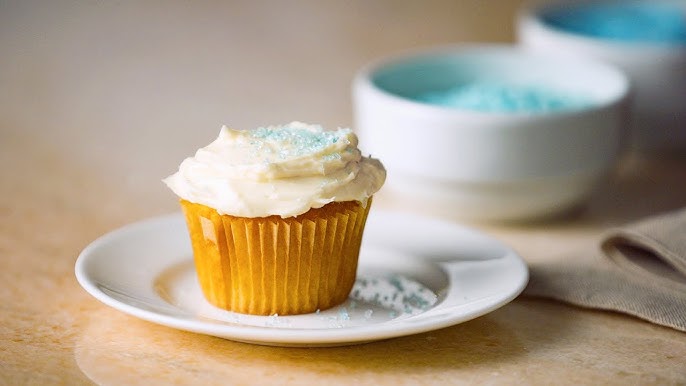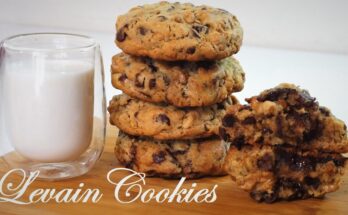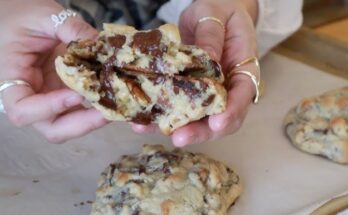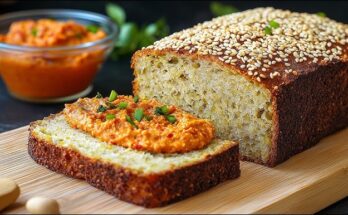Butter Cream Icing Recipe: Butter cream icing is the unsung hero of dessert decoration. Creamy, sweet, and versatile, it’s the go-to for beautifully frosted cakes, cupcakes, and cookies. Whether you’re aiming for a smooth layer or detailed piping designs, butter cream is the perfect base.
Today, I’ll walk you through a foolproof butter cream icing recipe that’s both easy and customizable!
What is Butter Cream Icing?
Butter cream icing is a rich and fluffy frosting made from butter and powdered sugar, whipped to perfection. Its origins can be traced back to European baking traditions, where butter was used to create luscious, velvety toppings.
There are a few variations of butter cream icing:
- American Butter Cream (simple, sweet, and widely used)
- Swiss Meringue Butter Cream (smoother and less sweet)
- Italian Meringue Butter Cream (light and stable)
- French Butter Cream (richer with egg yolks)
For this guide, we’ll stick with the classic American version—easy, quick, and perfect for beginners!
Ingredients Needed
Here’s what you’ll need to make a basic butter cream icing:
Essential Ingredients:
- Unsalted butter: 1 cup (softened)
- Powdered sugar: 4 cups (sifted)
- Milk or heavy cream: 2-3 tablespoons
- Vanilla extract: 1-2 teaspoons
Optional Add-ins:
- Food coloring (for decorative purposes)
- Flavor extracts (almond, lemon, peppermint, etc.)
- Salt (just a pinch to balance the sweetness)
Tools and Equipment Required
To make butter cream icing, you’ll want the right tools to get that silky smooth finish.
- Electric mixer (hand or stand mixer)
- Mixing bowl
- Rubber spatula
- Measuring cups and spoons
- Sifter or fine mesh strainer (for powdered sugar)
- Icing bags and piping tips (optional for decorating)
Having these tools on hand will save you time and effort.
How To Make Butter Cream Icing Recipe – Step by Step Guide
Step 1: Preparing the Ingredients
Before you begin, gather all your ingredients and make sure they are at the right temperature. Softened butter is key—it should be soft enough to press your finger into easily but not melted. This allows for proper aeration when creaming.
Tip: If you forgot to take your butter out, you can soften it quickly by cutting it into small cubes or microwaving it for 10-15 seconds (but be careful not to melt it!).
Sift your powdered sugar to remove any lumps, ensuring a smooth texture.
Step 2: Creaming the Butter
Place the softened butter in your mixing bowl and beat it on medium speed with your electric mixer. Cream the butter for about 2-3 minutes until it becomes pale and fluffy.
This step is crucial because it builds the base structure of your icing. Properly creamed butter traps air, giving the icing a light, airy texture.
Step 3: Gradually Adding the Sugar
Add the powdered sugar in small batches, about 1 cup at a time. Beat on low speed to prevent sugar clouds from filling your kitchen. Once incorporated, increase the speed to medium-high and continue mixing.
Repeat this process until all the sugar is added. By adding the sugar gradually, you avoid clumps and ensure a smooth, creamy consistency.
Step 4: Adding the Liquid Ingredients
Now it’s time to add your milk or heavy cream, along with the vanilla extract. Start with 1 tablespoon of liquid, then gradually add more until you reach your desired consistency.
For thicker icing (great for piping), use less liquid. For a spreadable consistency, add a bit more milk or cream. Keep beating until the icing is smooth and silky.
Step 5: Mixing Until Light and Fluffy
Continue mixing the icing for an additional 2-3 minutes. You want the butter cream to be light, fluffy, and easy to work with. Taste-test your icing at this point—if it’s too sweet, a tiny pinch of salt can help balance the flavor.
If you’re happy with the texture and flavor, you’re ready to move on to customization and decoration!
Step 6: Customizing the Icing
This is where you can have fun and get creative with your butter cream icing! Add a splash of your favorite flavor extract or incorporate food coloring to match your dessert theme.
Flavor Ideas:
- Vanilla Classic: Stick with the original vanilla extract for an elegant, sweet flavor.
- Chocolate: Add 2-3 tablespoons of cocoa powder for a rich chocolate icing.
- Almond or Citrus: Try almond extract for a nutty taste or lemon/orange zest for a refreshing twist.
- Peppermint: Great for holiday-themed desserts, just add a few drops of peppermint extract.
When adding food coloring, gel-based colors are best since they don’t affect the consistency of the icing. Mix in the coloring gradually to get the exact shade you want.
Common Mistakes and How to Avoid Them
Even experienced bakers can run into problems with butter cream icing. Here are some common mistakes and solutions:
- Grainy Icing: This can happen if the powdered sugar isn’t sifted or if it’s not fully dissolved. Always sift the sugar and beat the icing long enough for smoothness.
- Runny Icing: Adding too much liquid will thin out your icing. You can fix this by adding more powdered sugar a little at a time until it thickens.
- Overbeating: Mixing for too long can cause the icing to separate. Stop mixing once it’s fluffy and holds peaks.
By following these tips, you’ll avoid most pitfalls and achieve perfect butter cream every time.
Tips for Perfect Butter Cream Icing
Want bakery-level butter cream? Here are some pro tips to elevate your icing game:
- Use high-quality butter for the best flavor. European-style butter has a higher fat content, resulting in a richer taste.
- Chill your mixing bowl and beaters on warm days to prevent the butter from melting while mixing.
- Add liquid sparingly—it’s easier to add more liquid than to fix runny icing.
- Whip it at the end for a minute or two to introduce air and create that light, fluffy texture.
How to Use Butter Cream Icing
Butter cream is incredibly versatile. You can use it to spread a smooth layer on cakes, pipe elegant swirls on cupcakes, or decorate cookies with intricate designs.
Ideas for Using Butter Cream:
- Cakes: Apply a thin crumb coat to seal in any loose crumbs before adding the final layer of icing.
- Cupcakes: Fill a piping bag with icing and use different tips to create rosettes, swirls, or other designs.
- Cookies: Use a thin layer of butter cream as a base, then add decorative details with a smaller piping tip.
Whether you’re making a birthday cake or holiday treats, butter cream icing will elevate your desserts to the next level.
Storing and Preserving Butter Cream Icing
Got leftover icing? No problem—proper storage ensures it stays fresh for future use.
Storage Tips:
- Refrigeration: Store butter cream in an airtight container in the refrigerator for up to one week. Allow it to come to room temperature before using and rewhip if needed.
- Freezing: Freeze butter cream in a freezer-safe container for up to 3 months. Thaw overnight in the refrigerator and rewhip before decorating.
Avoid storing the icing near strong-smelling foods in the fridge, as it can absorb odors.
Health Considerations and Substitutions
While butter cream icing is delicious, it’s undeniably rich and sweet. If you’re looking for healthier or dietary-friendly alternatives, consider these options:
- Low-Sugar Version: Reduce the sugar and add cornstarch to maintain consistency.
- Dairy-Free Option: Use plant-based butter and non-dairy milk (e.g., almond or coconut milk).
- Vegan Butter Cream: Combine vegan butter with powdered sugar and plant-based milk for a cruelty-free alternative.
These substitutions will still give you a tasty, smooth icing without compromising too much on texture.
Troubleshooting Butter Cream Icing
Even after following the recipe, you might encounter issues. Here’s how to fix common problems:
- Runny Icing: Add more powdered sugar to thicken it up.
- Too Thick: Add a small amount of milk or cream and mix thoroughly until it loosens.
- Separated Icing: If your butter cream looks curdled, it may be too cold. Warm the bowl slightly and continue mixing until smooth.
Don’t panic—icing is very forgiving, and small adjustments can make a big difference!
Serving Suggestions and Pairings
Butter cream icing pairs beautifully with many desserts. Here are some of the best flavor combinations:
- Chocolate Cake + Vanilla Butter Cream: A classic combination that’s always a hit.
- Carrot Cake + Cream Cheese Butter Cream: Add a little cream cheese to the icing for a tangy twist.
- Red Velvet + Chocolate Butter Cream: Rich and decadent with complementary flavors.
- Sugar Cookies + Lemon Butter Cream: Light and refreshing with a zesty finish.
Experiment with your favorite desserts to find the perfect pairing!
FAQs about Buttercream Icing Recipe
What ingredients do I need for basic buttercream icing?
To make basic buttercream icing, you’ll need unsalted butter, powdered sugar, milk or heavy cream, and vanilla extract. Optionally, you can add a pinch of salt to enhance the flavors.
How do I ensure my buttercream is smooth and not grainy?
For smooth buttercream, make sure your butter is at room temperature before you start mixing. Sift your powdered sugar to eliminate any lumps, and add the liquid ingredients gradually, mixing on low speed until well incorporated.
Can buttercream icing be colored or flavored?
Absolutely! You can add food coloring to tint your buttercream and incorporate flavors like almond, lemon, or cocoa powder to diversify your icing options.
How long can I store buttercream icing?
Buttercream icing can be stored in the refrigerator for up to two weeks or in the freezer for up to three months. Be sure to cover it tightly and let it come to room temperature before re-whipping it for use.
Can buttercream icing be used under fondant?
Yes, buttercream is an excellent base for fondant. Ensure the buttercream layer is smooth and chilled so that the fondant will adhere properly and look smooth.
Is buttercream suitable for piping and decorating cakes?
Buttercream is ideal for piping and creating intricate cake decorations. For best results, use a buttercream that holds its shape well, such as American or Swiss meringue buttercream.
Does buttercream icing melt outside?
Buttercream can melt in hot environments because it’s butter-based. If you’re serving a cake outdoors, try to keep it in a cool, shaded area or use a buttercream alternative like ganache in very warm weather.
What’s the difference between American buttercream and other types like Swiss or Italian?
American buttercream is typically made with butter and powdered sugar, making it sweeter and thicker. Swiss and Italian buttercreams involve cooking egg whites with sugar before incorporating butter, resulting in a smoother, less sweet frosting that’s more stable in warmer conditions.
Conclusion
There you have it—a complete guide to making perfect butter cream icing! By following these steps and tips, you’ll create a delicious, customizable frosting that’s sure to impress. Whether you’re frosting a birthday cake or decorating cupcakes for a special occasion, butter cream icing will take your baking to the next level.
Now it’s your turn! Grab your ingredients, follow the steps, and let your creativity shine. Happy decorating!



